To train your dog effectively, start with basic commands like "sit" and "stay." Use positive reinforcement, rewarding your pup immediately for good behavior. Be consistent with commands and practice regularly, keeping sessions short—about 5 to 10 minutes. Socialize your dog early to enhance their adaptability and confidence. Consider clicker training for clear communication, and teach leash manners to improve walks. Reinforce good behavior with treats and praise, and remember that regular exercise is key to reducing destructive habits. Stick around, and you'll discover even more strategies to help your furry friend become the best companion possible!
Start With Basic Commands

When you bring a new dog into your home, teaching basic commands is the foundation for a well-behaved pet. Start with simple commands like "sit," "stay," "come," and "down." These commands not only help establish your authority but also improve communication between you and your dog.
Begin with "sit." Hold a treat above your dog's nose and move it back over their head. As their head moves up, their bottom will lower. Once they're sitting, say "sit" and reward them. Practice this in short sessions, repeating it a few times until they understand.
Next, introduce "stay." Ask your dog to sit, then take a step back. If they remain, reward them. If they move, guide them back and try again. Gradually increase the distance and time they stay.
For "come," use a leash to guarantee they return when called. Say "come" in a happy tone, and reward them when they approach.
Lastly, teach "down" by guiding them into a lying position with a treat. Use consistent commands and gestures to reinforce learning. Remember, patience is key; every dog learns at their own pace.
Use Positive Reinforcement
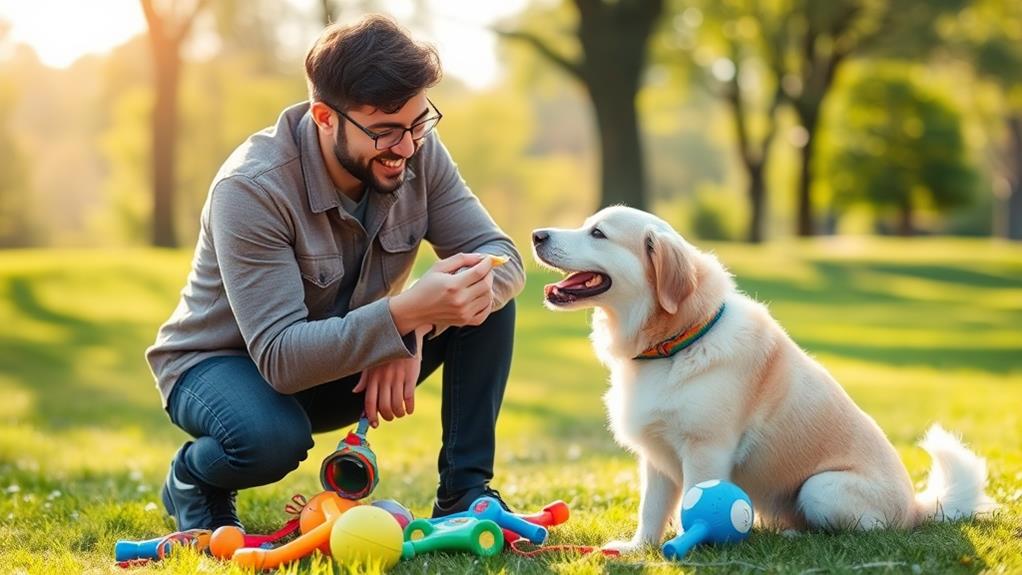
Positive reinforcement is an effective method that strengthens your dog's learning and builds a trusting relationship. Instead of focusing on negative behaviors, you're encouraging the good ones. When your pup performs a desired action, reward them immediately with treats, praise, or playtime. This creates a positive association, making them more likely to repeat the behavior.
Start by identifying what motivates your dog the most. Some dogs respond well to food rewards, while others might prefer verbal praise or a favorite toy. Experiment a little to see what gets your pup excited. When teaching commands, like "sit" or "stay," use positive reinforcement to reward them as soon as they comply. This helps your dog understand what you want and reinforces their learning.
Keep training sessions short and fun. Dogs have limited attention spans, so aim for 5-10 minutes per session. If your dog seems bored or frustrated, take a break and try again later. Remember, patience is essential. Celebrate small victories, and don't forget to be enthusiastic. Your positive energy will motivate your dog, making training an enjoyable experience for both of you!
Be Consistent With Training
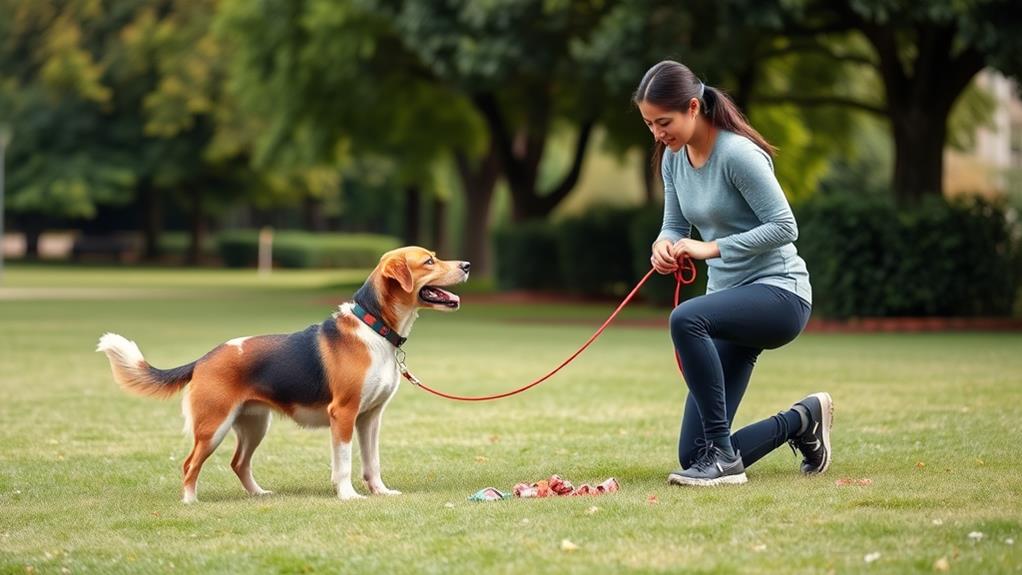
To build on the foundation of positive reinforcement, consistency in training is key. When you remain consistent with your commands, cues, and rewards, your dog will better understand what you expect from them. Inconsistency can confuse your pup, leading to unwanted behaviors and frustration for both of you.
Here are some essential tips to help you maintain consistency during training:
- Use the same commands: Stick to one word or phrase for each command. Avoid switching between different terms for the same action.
- Set a training schedule: Designate specific times for training sessions and stick to them. Regular practice reinforces learning.
- Involve the whole family: Guarantee everyone in your household uses the same commands and methods. This helps prevent mixed signals.
- Reward immediately: Give praise or treats right after your dog performs the desired behavior. This immediate reinforcement helps solidify their understanding.
Keep Training Sessions Short

Keeping training sessions short is essential for maintaining your dog's focus and enthusiasm. Dogs have limited attention spans, so aim for sessions that last about 5 to 10 minutes. This shorter duration helps prevent boredom and keeps your pup engaged, making learning more effective.
During these brief sessions, focus on one or two commands or behaviors at a time. When your dog masters a command, gradually increase the difficulty or introduce a new one. Use positive reinforcement by rewarding your dog with treats, praise, or playtime immediately after they successfully perform the desired behavior. This builds a strong connection between the command and the reward.
It's also important to practice at various times throughout the day. Instead of one long training session, break it into several short ones. This technique not only helps reinforce what your dog has learned but also integrates training into your daily routine.
Socialize Your Dog Early
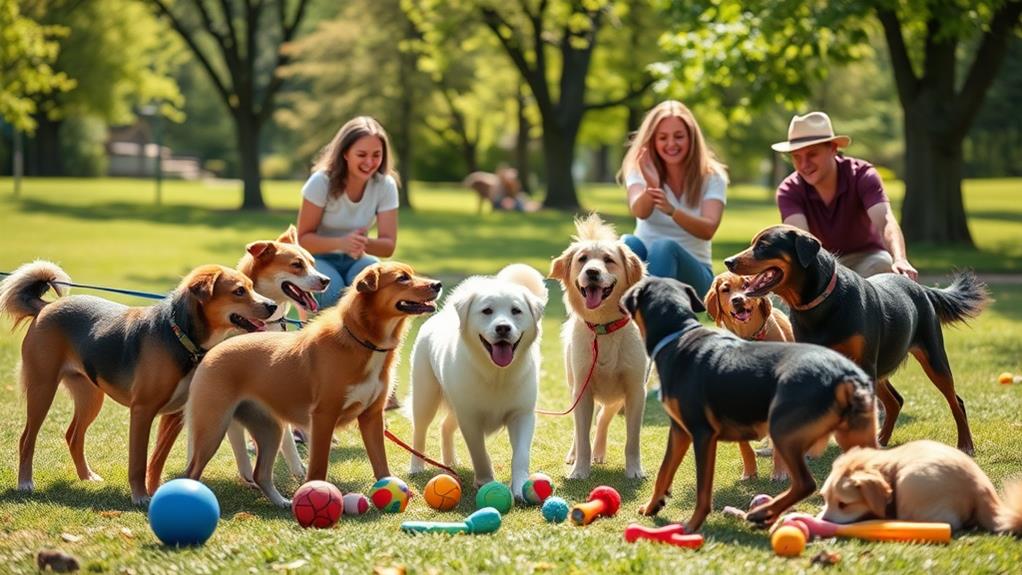
Why is early socialization pivotal for your dog? It lays the foundation for a well-adjusted, confident pup. By exposing your dog to a variety of people, environments, and other animals during their critical developmental period, you're helping them learn how to navigate the world safely and comfortably. The earlier you start this process, the better equipped your dog will be to handle new experiences.
- Reduces Fearfulness: Dogs that are socialized early are less likely to develop anxiety or fear towards unfamiliar situations.
- Enhances Behavior: Proper socialization minimizes undesirable behaviors like excessive barking, aggression, or shyness.
- Builds Confidence: A well-socialized dog is more self-assured, allowing them to adapt to different environments with ease.
- Promotes Friendliness: Regular interaction with various stimuli certifies your dog is friendly and approachable around others, including pets and people.
Manage Distractions Effectively
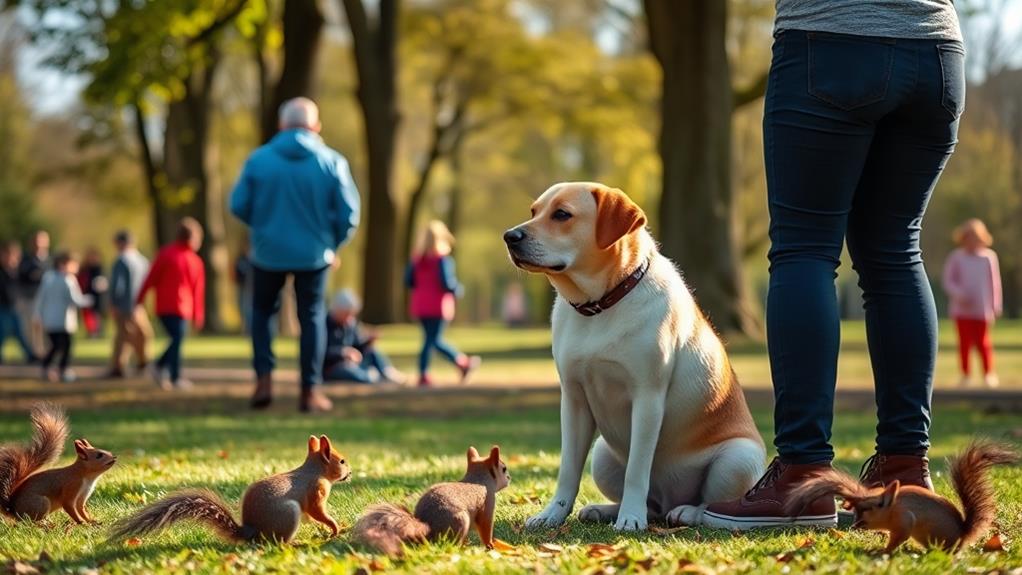
Managing distractions effectively is crucial for successful dog training. To start, identify what distracts your pup most, whether it's other dogs, loud noises, or people. Once you know their triggers, you can create a controlled environment to minimize these distractions.
Begin training in a quiet space where interruptions are minimal, gradually introducing mild distractions as your dog becomes more focused.
Use high-value treats to maintain your dog's attention. When distractions appear, redirect their focus back to you with these rewards. Practice commands such as "sit" or "stay" while gradually increasing the level of distraction. This helps your dog learn to ignore distractions over time.
Consistency is key. If your dog responds well to a command amidst distractions, reward them immediately. On the other hand, if they struggle, go back to a less distracting environment to reinforce their training.
Don't forget to practice regularly. Frequent exposure to distractions in controlled settings will help your dog learn to stay focused, making training sessions more effective. Remember, patience and persistence are essential in this process. With time and practice, your pup will become more adept at managing distractions.
Use Clicker Training Techniques

Clicker training techniques are often effective in reinforcing desired behaviors in dogs. This method utilizes a small device that makes a distinct sound, signaling to your pup that they've done something right. When you pair the click with a treat, your dog quickly learns to associate the sound with positive reinforcement.
Timing is key: Click the moment your dog performs the desired behavior to create a clear connection.
Use high-value treats: Choose treats your dog loves to increase their motivation during training sessions.
Keep sessions short: Aim for 5-10 minute sessions to maintain your dog's focus and enthusiasm.
Gradually reduce treats: Once your dog consistently performs the behavior, start clicking without treating every time, phasing out the rewards.
Teach Leash Manners

Training your dog to have good leash manners is essential for enjoyable walks. Start by choosing the right equipment. A well-fitted harness or collar will help you maintain control without causing discomfort. When you begin, keep your walks short and distraction-free.
Use a consistent cue like "Let's go!" as you start walking. If your dog pulls ahead, stop immediately. Stand still until they return to your side. This teaches them that pulling won't get them where they want to go. As soon as they're beside you, praise them and resume walking.
Practice makes perfect, so try to train in different environments to help your dog generalize the behavior. If they get distracted, gently guide them back to your pace. If they stay focused, reward them with a treat or a little playtime.
Reinforce Good Behavior

Reinforcing good behavior is crucial for effective dog training. When your pup knows what behaviors earn them rewards, they're more likely to repeat those actions. Positive reinforcement builds trust and strengthens your bond, making training a more enjoyable experience for both of you.
Use Treats: Offer small, tasty treats immediately after your dog exhibits the desired behavior. This helps them associate the action with a positive outcome.
Praise Verbal Praise: Use enthusiastic words and a cheerful tone. Dogs respond well to your excitement and will want to hear more!
Physical Affection: Petting or belly rubs can be a great reward. Your dog loves your touch, and it reinforces their good behavior.
Short Training Sessions: Keep training sessions brief and fun. This prevents boredom and keeps your pup engaged, increasing the likelihood of repeat behaviors.
Exercise and Play Regularly
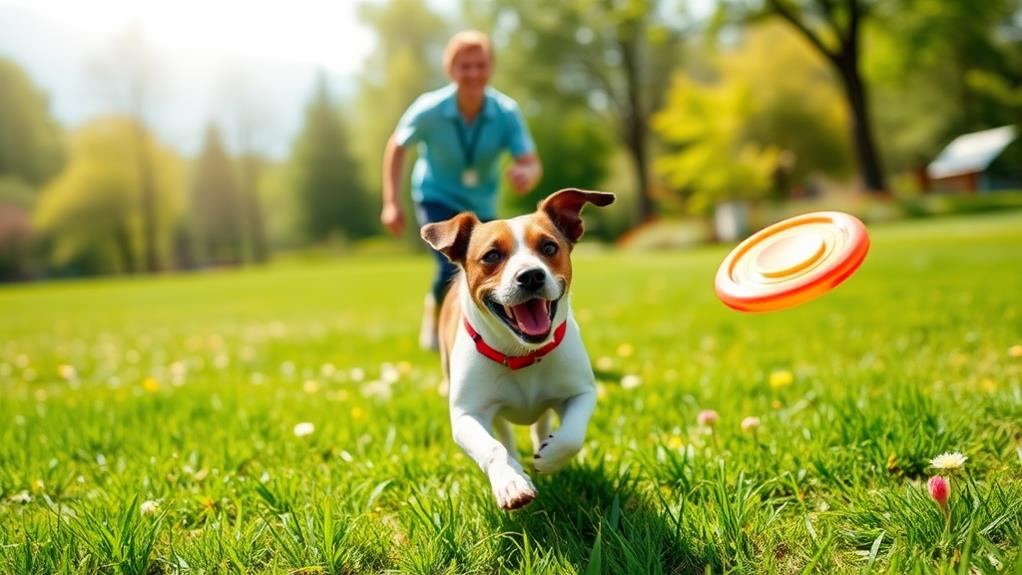
Regular exercise and play are essential for your dog's physical and mental well-being. When you engage in regular activities, you help prevent obesity, reduce anxiety, and strengthen your bond with your pup.
Aim for at least 30 minutes to an hour of exercise daily, depending on your dog's breed, age, and energy level.
Mix it up with walks, runs, or fetch games to keep things interesting. Dogs love variety, and different activities can stimulate both their body and mind. Consider incorporating agility courses or puzzle toys to challenge them further.
Don't forget about socialization! Arranging playdates with other dogs can enhance your dog's social skills and provide essential stimulation.
You'll find that a well-exercised dog is often a well-behaved dog. When your pup's energy is spent, they're less likely to engage in destructive behaviors.
Frequently Asked Questions
How Do I Choose the Right Treats for Training?
When choosing treats for training, consider your dog's preferences and dietary needs. Opt for small, soft, and flavorful options that'll motivate them. Experiment a bit to find what excites your pup the most!
What Should I Do if My Dog Refuses to Learn?
If your dog refuses to learn, reassess your methods. Try different rewards, keep sessions short, and maintain a distraction-free environment. Patience and consistency are indispensable; celebrate small successes to build confidence in your pup.
Can I Train an Older Dog Successfully?
Absolutely, you can train an older dog successfully! It just takes patience and consistency. Focus on positive reinforcement, keep sessions short, and celebrate small victories to help your dog learn and thrive at any age.
How Do I Handle Stubborn or Defiant Behavior?
When dealing with stubborn behavior, you've got to stay consistent and patient. Use positive reinforcement, set clear boundaries, and keep training sessions short. Remember, it's all about building trust and understanding over time.
Are There Specific Breeds That Are Harder to Train?
Think of a cat trying to learn tricks; some dog breeds can be just as stubborn. Breeds like Bulldogs and Dachshunds often require more patience and tailored strategies to achieve effective training outcomes. You've got this!
Conclusion
By following these ten proven tips, you'll transform your pup into a well-behaved companion. You might think training takes too much time, but imagine enjoying peaceful walks without pulling or chaotic trips to the park. With short, engaging sessions and plenty of play, both you and your dog will look forward to training. Embrace the journey, and watch as your furry friend blossoms into a joy to be around. You'll both be happier for it!



